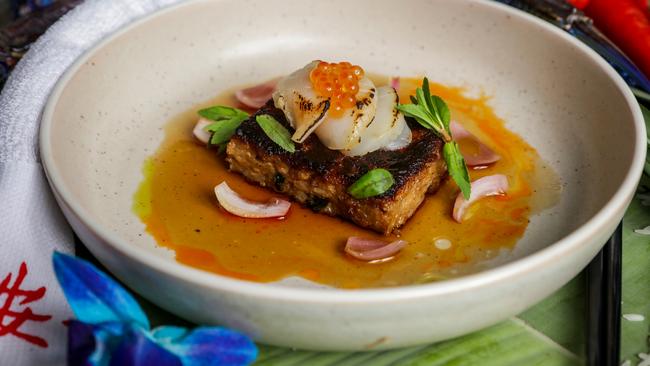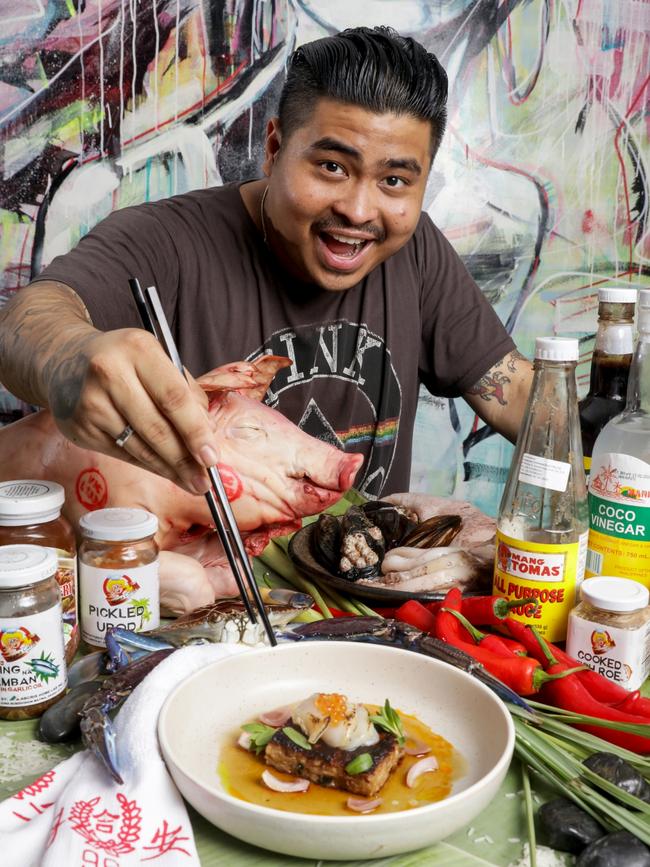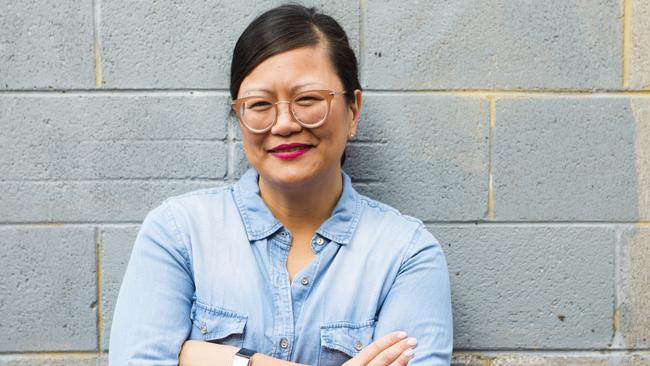Melbourne’s latest food trend perfect for summer
Simple, tropical flavours cooked over flames — it’s an Asian cuisine that’s perfect for our climate, but few Melburnians could name any of its dishes. Here’s where you can get a taste.

Eating Out
Don't miss out on the headlines from Eating Out. Followed categories will be added to My News.
Simple, tropical food grilled over coal or cooked over flame that’s big on flavours that play with the salty-sweet-sour triumvirate sounds like exactly the type of food that’s good to eat on a hot summer’s night.
But unlike char sui pork or tandoori chicken, many of us would struggle to name one Filipino dish – even though Australia is home to almost a quarter of a million people of Filipino heritage, the third-largest population of Asian-Australians behind Chinese and Indian.
But a new generation of chefs want to change that, harnessing their heritage and introducing diners to the flavours of their childhoods but in dishes interpreted for the modern Melbourne dining scene.
MORE: BEST DISHES OF 2018
REVIEW: WHY YOU SHOULD VISIT THIS PENINSULA NEWBIE

John Rivera – who represented the Pacific region in the prestigious S.Pellegrino Young Chef world cooking competition last year – has just taken the reigns of the kitchen at South Melbourne’s acclaimed Lume restaurant and has launched his first menu that features Filipino flavours “without being blatantly Filipino”.
Rice Paper Sister’s Ross Magnaye serves a signature modern “pinoy” pork jowl with adobo sauce at the CBD restaurant to great acclaim, while a collective of female Filipino foodies known as The Entrée.Pinays formed last year to raise awareness of the cuisine and its culinary talents.


It’s not just here that is gaining new-found appreciation of a cuisine that incorporates a diverse range of influences including Malay, Chinese, Japanese, Spanish and American.
After moving to New York and discovering lack a great Filipino restaurants, Nicole Ponseca took matters into her own hands and opened Maharlika, a modern Filipino bistro, and soon after Jeepney, a Filipino Gastropub, and has since authored the book I Am A Filipino: and this is how we cook.

And for putting modern Filipino cooking on the map in the heart of his hometown Manila, Jordy Navarra was crowned the One to Watch at Asia’s 50 Best Restaurants awards 2018.
At Toyo Eatery, Navarra serves a dish of the 18 vegetables featured in a popular children’s song “Bahay Buko” that are transformed into an artful salad.
“I always wanted to cook something I could relate to,” Jordy says, who along with Nicole will be in town in March as part of the 2019 Melbourne Food and Wine Festival. “I wanted to work with ingredients and flavours that I understand intimately.”
FLAVOUR SAVOUR
Those flavours include a balance of salty, sweet and sour – with sour being favoured over others.
“Sourness plays a significant part in our food, whether the dish is soured with unripe fruit, accompanying a dish as a dipping sauce, or condiment,” John says. “We play towards the extremities of these flavours, pushing it to create something deliciously lipsmacking, or as we call it, malinamnam.”
At its core, it’s a surprisingly simple cuisine, Jordy says, with dishes usually grilled, stewed or steamed. “We don’t really use a lot of spices, generally highlighting the flavours of the ingredients themselves. You normally see only a few, like peppercorns, bay leaf, star anise and turmeric.”
DELISH DISHES
The most famous Filipino dish is adobo – a sweet and sour stew usually made with pork or chicken.
“It’s the most popular dish in the Philippines and it’s actually my favourite,” Ross says. “You can use chicken and pork but I love it when it’ made with both mixed together.”
John agrees, but says patience is needed when cooking adobo. “We always wait until the next day to eat it,” Filipinos swear that adobo the next day is even better.”

Fides Santos-Arguelles from The Entrée.Pinays says silog is another must-try dish. “This is a traditional breakfast of garlic fried rice and fried egg served with a tangy green papaya pickle called atsara and your choice of protein.”
Typical choices include salted fish (bangus), sweet glazed pork (tocino) or a potent garlic sausage called longganisa.
PIG OUT
The late, great Anthony Bourdain declared it “the best pig, ever!” when he tried lechon in Cebu city, which is said to cook the country’s the best version of the dish.

And it’s easy to see why. A whole pig in aromatics such as lemongrass, pandan and spring onions and rubbed with garlic, chillies and salt and then carefully turned and roasted for hours over hot coals until its skin is brick-red and glasslike, its flesh succulent and juicy. It’s a craft lechoneros – the equivalent to a US barbecue pitmaster – take extremely seriously.
“Filipinos have a porcine obsession, so every grand celebration is capped off with lechon,” John says.
SEAFOOD, EAT IT
Being a nation made up of more than 7000 islands seafood, of course, features heavily in the cuisine with kinlaw – the Filipino version of ceviche, or citrus-cured fish – popular throughout the country.
To make a basic kinlaw, Jordy Navarra suggests chopping red onion, a bird’s eye chilli and ginger, mixing with warmed vinegar to infuse the flavours. Set aside to cool, then season with fish sauce. Chop your choice of fish – he suggests mackerel, but tuna is also often used – into chunks and mix with the vinegar. “This is best eaten with grilled pork,” he says.
Ross says a dish called sinuglaw combines the best of both worlds. “It’s kinlaw but salty grilled pork rashers are added to it. Perfection!”
Fresh fish is often served simply grilled or fried along with a variety of dipping sauces and condiments while salted and dried fish is often eaten at breakfast.
“Preserving fish roe is another delicacy in the Philippines,” Ross says. “My grandma Carol has her own product in Davao City – Mama Carol’s – that’s preserved with salt and lemon rind. It’s a condiment usually eaten with grilled proteins and rice.”
LIFE IS SWEET
Translating as “mix mix” the most popular dessert in the Philippines is halo halo, which Fides describes as a “glorious, nonsensical riot of shaved ice topped with sweetened beans, fruit jelly, coconut gel (nata de coco) topped with vibrant ube (purple yam) ice cream and leche flan (cream caramel)”.
John says it’s one of the best ways to cool down in the tropical Philippine heat and is also delicious on a hot Melbourne summer’s day.
WHERE TO TRY FILIPINO FOOD
Rice Paper Sister, Hardware Lane, CBD
Ponsos Grill, Filipino-style BBQ on a stick, a pop up at The Friars Market, South Melbourne
GJ Grills, Franklin Street, CBD opposite Queen Victoria Market
Papabear Bakehouse and Masarap Bakery, both in Braybrook for fresh pandesal and other Filipino baked goods
The Little Jeepney Food Truck (the first Filipino food truck in Australia. Check @thelittlejeepney for locations)
Hoy Pinoy food truck hoypinoy.com.au
DO THIS
The Melbourne Food and Wine Festival will turn a spotlight on Filipino cuisine and chefs as part of the 2019 program of events.
Jordy Navarra and Nicole Ponseca will hold a masterclass at The House of Food and Wine on Mar 10. John Rivera will also join fellow S. Pellegrino Young Chef finalist Jake Kellie in hosting a masterclass on the same day.

As part of the Global Dining series, The Entrée.Pinays will host a dinner where Jordy and Nicole will join Ross Magnaye in the Rice Paper Sister kitchen for a night of fabulous Filipino food on March 12 and 13 (tickets selling fast).
General admission day passes to the House of Food and Wine start at $65. For more info and to book: MFWF.com.au
FILIPINO FOOD GLOSSARY
Adobo – cooked in vinegar, soy sauce and garlic
Guisado – sauteed
Sinigang – boiled with a sour fruit or vegetable, typically green tamarind
Paksiw – cooked in vinegar and garlic
Estofado – prepared with a burnt sugar sauce
Ginataan – cooked in coconut milk
Rellanado – stuffed
Sarciado – a sauce
— Source: The Entrée.Pinays



